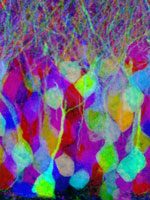WEB FOCUS
Circuits and innate behaviour

In this issue
In recent years, neuroscientists have made great strides in understanding the mechanisms and processes of innate behaviour as well as the circuits (both anatomical and molecular) that mediate them. For instance, a new Nature paper describes a powerful method to uniquely label individual cells within a population, and thereby distinguish adjacent neurons and cellular processes. This genetic labelling of neurons with multiple distinct colours allows for the large-scale analysis of neuronal circuits. Another paper in the same issue uses calcium imaging and genetic techniques to characterize the circuits in Caenorhabditis elegans that control food and odour-evoked behaviour.
This special web focus highlights some of the advances in understanding both the circuits and the mechanisms of innate behaviours (such as sexual behaviour, olfaction, sleep and touch) made in the past year. We also present some of the recent technical breakthroughs that hold great promise for the dissection of such circuits and their functions.
Image Credit: Jean Livet, Ryan Draft and Jeff Lichtman
Top of page
News Feature
A Gut Feeling
Ishani Ganguli
Nature 450, 21 (1 November 2007) doi:10.1038/450021a
Top of page
Current Research
ARTICLE
Transgenic strategies for combinatorial expression of fluorescent proteins in the nervous system
Jean Livet et al.
Nature 450, 56–63 (1 November 2007) doi:10.1038/nature06293
Abstract | Full Text | PDF | Supplementary Information
ARTICLE
Dissecting a circuit for olfactory behaviour in Caenorhabditis elegans
Sreekanth H. Chalasani et al.
Nature 450, 63–70 (1 November 2007) doi:10.1038/nature06292
Abstract | Full Text | PDF | Supplementary Information
NEWS AND VIEWS
Smell: The worm turns
The worm Caenorhabditis elegans has many advantages as an experimental organism. These have been exploited to investigate how,
at a single-neuron level, neural circuits transform sensory signals into behaviour.
Piali Sengupta
Nature 450, 35–36 (1 November 2007) doi:10.1038/450035a
Top of page
Podcast

Hear more about the genetic labelling of individual neurons within a population with distinct colours, allowing the large-scale visualization of neuronal connectivity.
Top of page
Links
Top of page
Archive
Sexual behaviour
LETTER
An essential role for a CD36-related receptor in pheromone detection in Drosophila
Richard Benton, Kirsten S. Vannice & Leslie B. Vosshall
Nature advance online publication (17 October 2007) doi:10.1038/nature06328
ARTICLE
A functional circuit underlying male sexual behaviour in the female mouse brain
Tali Kimchi, Jennings Xu & Catherine Dulac
Nature 448, 1009–1014 (30 August 2007) doi:10.1038/nature06089
Abstract | Full Text | PDF | Supplementary Information
NEWS AND VIEWS
Females can also be from Mars
Nirao M. Shah & S. Marc Breedlove
Nature 448, 999–1000 (30 August 2007) doi:10.1038/nature05892
LETTER
A single class of olfactory neurons mediates behavioural responses to a Drosophila sex pheromone
Amina Kurtovic, Alexandre Widmer & Barry J. Dickson
Nature 446, 542–546 (29 March 2007) doi:10.1038/nature05672
Abstract | Full Text | PDF | Supplementary Information
Somatosensation
LETTER
A gastrin-releasing peptide receptor mediates the itch sensation in the spinal cord
Yan-Gang Sun & Zhou-Feng Chen
Nature 448, 700–703 (9 August 2007) doi:10.1038/nature06029
Abstract | Full Text | PDF | Supplementary Information
LETTER
The menthol receptor TRPM8 is the principal detector of environmental cold
Diana M. Bautista et al.
Nature 448, 204–208 (12 July 2007) doi:10.1038/nature05910
Abstract | Full Text | PDF | Supplementary Information
NEWS AND VIEWS
Channelling cold reception
Bernd Nilius & Thomas Voets
Nature 448, 147–148 (12 July 2007) doi:10.1038/448147a
LETTER
Sensory neuron sodium channel Nav1.8 is essential for pain at low temperatures
Katharina Zimmermann et al.
Nature 447, 856–859 (14 June 2007) doi:10.1038/nature05880
Abstract | Full Text | PDF | Supplementary Information
LETTER
A stomatin-domain protein essential for touch sensation in the mouse
Christiane Wetzel et al.
Nature 445, 206–209 (11 January 2007) doi:10.1038/nature05394
Abstract | Full Text | PDF | Supplementary Information
Chemosensation
LETTER
The detection of carbonation by the Drosophila gustatory system
Walter Fischler, Priscilla Kong, Sunanda Marella & Kristin Scott
Nature 448, 1054–1057 (30 August 2007) doi:10.1038/nature06101
Abstract | Full Text | PDF | Supplementary Information
LETTER
Hebbian STDP in mushroom bodies facilitates the synchronous flow of olfactory information in locusts
Stijn Cassenaer & Gilles Laurent
Nature 448, 709–713 (9 August 2007)) doi:10.1038/nature05973
Abstract | Full Text | PDF | Supplementary Information
NEWS AND VIEWS
Timing is everything
Phillip Larimer & Ben W. Strowbridge
Nature 448, 652–654 (9 August 2007) doi:10.1038/448652a
LETTER
Two chemosensory receptors together mediate carbon dioxide detection in Drosophila
Walton D. Jones, Pelin Cayirlioglu, Ilona Grunwald Kadow & Leslie B. Vosshall
Nature 445, 86–90 (4 January 2007) doi:10.1038/nature05466
Abstract | Full Text | PDF | Supplementary Information
NEWS AND VIEWS
Scent secrets of insects
Rachel I. Wilson
Nature 445, 30–31 (4 January 2007) doi:10.1038/445030a
Other innate behaviours
LETTER
Neural substrates of awakening probed with optogenetic control of hypocretin neurons
Antoine R. Adamantidis, Feng Zhang, Alexander M. Aravanis, Karl Deisseroth & Luis de Lecea
Nature advance online publication (17 October 2007) doi:10.1038/nature06310
LETTER
Light adaptation in cone vision involves switching between receptor and post-receptor sites
Felice A. Dunn, Martin J. Lankheet & Fred Rieke
Nature 449, 603–606 (4 October 2007) doi:10.1038/nature06150
Abstract | Full Text | PDF | Supplementary Information
BOOKS AND ARTS
Atlas on our shoulders
Edvard I. Moser
Nature 449, 406 (27 September 2007) doi:10.1038/449406a
ESSAY
The structure of consciousness
György Buzsáki
Nature 446, 267 (15 March 2007) doi:10.1038/446267a
LETTER
Hippocampal remapping and grid realignment in entorhinal cortex
Marianne Fyhn, Torkel Hafting, Alessandro Treves, May-Britt Moser & Edvard I. Moser
Nature 446, 190–194 (8 March 2007) doi:10.1038/nature05601
Abstract | Full Text | PDF | Supplementary Information
LETTER
A topographic map of recruitment in spinal cord
David L. McLean, Jingyi Fan, Shin-ichi Higashijima, Melina E. Hale & Joseph R. Fetcho
Nature 446, 71–75 (1 March 2007) doi:10.1038/nature05588
Abstract | Full Text | PDF | Supplementary Information
Technical advances in probing circuits
ARTICLE
Multimodal fast optical interrogation of neural circuitry
Feng Zhang et al.
Nature 446, 633–639 (5 April 2007) doi:10.1038/nature05744
Abstract | Full Text | PDF | Supplementary Information
NEWS AND VIEWS
Controlling neural circuits with light
Michael Hausser & Spencer L. Smith
Nature 446, 617–619 (5 April 2007) doi:10.1038/446617a
